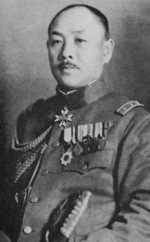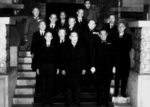Korechika Anami
| Surname | Anami |
| Given Name | Korechika |
| Born | 21 Feb 1887 |
| Died | 15 Aug 1945 |
| Country | Japan |
| Category | Military-Ground |
| Gender | Male |
ww2dbaseKorechika Anami was born in Taketa, Oita Prefecture, Japan in 1887. His father, Nao Anami, was an official in the Home Ministry. He grew up in Tokyo, Japan and in Tokushima Prefecture. Aspiring to be an officer from a young age, he looked up to General Count Maresuke Nogi. In Sep 1900, he graduated from a military junior academy in Hiroshima, Japan. He attended the Army Academy between Nov 1905 and Dec 1906. Upon graduation, he was made a second lieutenant and was attached to the 1st Infantry Regiment. In Dec 1908, he was promoted to the rank of lieutenant. In Nov 1910, he was attached to a military academy. In Nov 1916, he was promoted to the rank of captain. In Nov 1918, he graduated from the Army Staff College. In Apr 1919, he was attached to the Army General Staff Headquarters. In Feb 1922, he was promoted to the rank of major. In Aug 1923, he was named the chief of staff of the Sakhalin Expeditionary Army, which was the occupation army for the Russian (northern) half of Sakhalin island. In Aug 1925, he was promoted to the rank of lieutenant colonel. In Apr 1926, he was attached to the Army High Command. In Aug 1927, he was posted to France as a military attaché. In Dec 1927, he was attached to 45th Infantry Regiment; in Aug 1928, he was made the regiment's commanding officer. In Aug 1929, he was made an army advisor to Emperor Showa. In Aug 1930, he was promoted to the rank of colonel. In Aug 1933, he was made the commanding officer of the 2nd Guards Infantry Regiment. In Aug 1934, he was made the Commandant of the Tokyo Military Preparatory School in Tokyo, Japan. In Mar 1935, he was promoted to the rank of major general. In Aug 1936, he was made the head of the Military Affairs Bureau of the Army Ministry. In Mar 1937, he was made the head of the Personnel Bureau of the same ministry.
ww2dbaseAfter the war began in Asia, Korechika Anami was promoted to the rank of lieutenant general in Mar 1938. He rose to divisional command later that year when he was given the 109th Division; in that role, he saw combat in China. Returning to Japan in the fall of 1939, he was made the deputy commanding officer of the Japanese Army in Oct 1939. In Apr 1941, he was made the commanding officer of the 11th Army, which was fighting in central China. In this role, he participated in the Sep 1941 Second Battle of Changsha, which resulted in the Japanese Army failing to capture the Chinese city in Hunan Province. In Jul 1942, he was made the commanding officer of the 2nd Area Army, which was stationed in northeastern China in the Japanese-sponsored puppet state of Manchukuo. In May 1943, he was promoted to the rank of general. In Nov 1943, his 2nd Area Army was moved to the occupied Dutch East Indies. In Dec 1944, he was made the Inspector General of Army Aviation and a member of the Supreme War Council. In Apr 1945, he was made the Army Minister in Prime Minister Kantaro Suzuki's cabinet. As a cabinet minister, he counseled the prime minister against surrendering, proposing to organize defenses designed to inflict maximum damage to invaders. This continued even after the first atomic bombing against the city of Hiroshima, Japan; he argued that it was unlikely for the United States to have more than one operational atomic bomb. His fierce opposition to surrender finally ceased when Emperor Showa announced his intention to end the war. He ordered his subordinates to obey the Emperor, and he refused to join the coup d'état that took place in the final hours of the war. In the morning of 15 Aug 1945, after signing a surrender document of the prime minister's cabinet, he committed seppuku ritual suicide.
ww2dbaseAnami was buried at the municipal Tama Cemetery in Fuchu in western Tokyo, Japan. His sword and blood-stained dress uniform were given to the Yushukan Museum in Tokyo.
ww2dbaseSource: Wikipedia
Last Major Revision: Oct 2017
Korechika Anami Interactive Map
Photographs
 |  |
Korechika Anami Timeline
| 21 Feb 1887 | Korechika Anami was born in Taketa, Oita Prefecture, Japan. |
| 10 Aug 1928 | Korechika Anami was made the commanding officer of 45th Infantry Regiment. |
| 1 Aug 1929 | Korechika Anami was made an army advisor to Emperor Showa. |
| 1 Aug 1930 | Korechika Anami was promoted to the rank of colonel. |
| 1 Aug 1933 | Korechika Anami was made the commanding officer of 2nd Guards Infantry Regiment. |
| 1 Aug 1934 | Korechika Anami was made the Commandant of the Tokyo Military Preparatory School in Tokyo, Japan. |
| 15 Mar 1935 | Korechika Anami was promoted to the rank of major general. |
| 1 Aug 1936 | Korechika Anami was made the head of the Military Affairs Bureau of the Army Ministry. |
| 1 Mar 1937 | Korechika Anami was made the head of the Personnel Bureau of the Army Ministry. |
| 1 Mar 1938 | Korechika Anami was promoted to the rank of lieutenant general. |
| 9 Nov 1938 | Korechika Anami was made the commanding officer of 109th Division. |
| 12 Sep 1939 | Korechika Anami was attached to the Army General Staff. |
| 14 Oct 1939 | Korechika Anami was made the deputy commanding officer of the Japanese Army. |
| 29 Apr 1940 | Korechika Anami was awarded Grand Cordon of the Order of the Rising Sun, first class. |
| 10 Apr 1941 | Korechika Anami was made the commanding officer of 11th Army. |
| 9 Dec 1941 | Korechika Anami was awarded the Pillars of State medal of the puppet state of Manchukuo. |
| 1 Jul 1942 | Korechika Anami was made the commanding officer of the 2nd Area Army in northeastern China. |
| 1 May 1943 | Korechika Anami was promoted to the rank of general. |
| 26 Dec 1944 | Korechika Anami was made the Inspector General of Army Aviation and a member of the Supreme War Council. |
| 7 Apr 1945 | Korechika Anami was made the Army Minister under Prime Minister Kantaro Suzuki. |
| 14 Aug 1945 | Korechika Anami practiced kendo for the entire afternoon while he considered the war situation. |
| 15 Aug 1945 | Korechika Anami, as the Army Minister, signed an official document of surrender. He then committed ritual suicide in Kojimachi (now Chiyoda), Tokyo, Japan. |
Please consider supporting us on Patreon. Even $1 per month will go a long way! Thank you. Please help us spread the word: Stay updated with WW2DB: |
» Second Battle of Changsha
- » 1,171 biographies
- » 337 events
- » 44,911 timeline entries
- » 1,244 ships
- » 350 aircraft models
- » 207 vehicle models
- » 376 weapon models
- » 123 historical documents
- » 261 facilities
- » 470 book reviews
- » 28,520 photos
- » 365 maps
Lt. Gen. Lewis B. "Chesty" Puller, at Guadalcanal